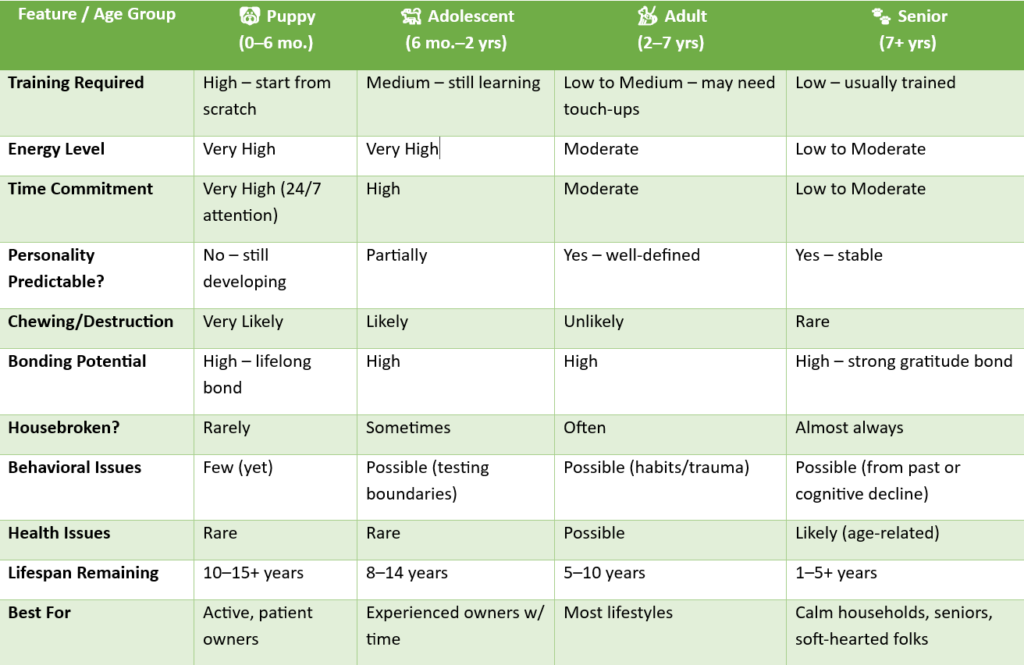Adopting a dog at different life stages—puppy, adolescent, adult, or senior—comes with unique benefits and challenges. Here’s a breakdown to help you figure out what fits your lifestyle best:

🐶 Puppy (0–6 months)
✅ Pros:
- Training from scratch: You can shape behavior and habits early on.
- Bonding: Strong attachment tends to form when raising from a young age.
- Cute factor: They’re adorable and fun to play with.
- Health baseline: Usually free of prior trauma or health issues.

❌ Cons:
- Time-consuming: Housebreaking, chewing, teething, and obedience training are demanding.
- Unpredictable traits: Personality and size can change as they grow.
- High energy: Needs lots of stimulation and exercise.
🐕 Adolescent Dog (6 months–2 years)
✅ Pros:
- More independent: Slightly less work than a young puppy.
- Still trainable: Can learn quickly and adapt to new environments.
- Developmental insight: You start to see their real personality.

❌ Cons:
- “Teen phase” behavior: May test boundaries, be stubborn, or develop new unwanted behaviors.
- Energy surge: Often very active and mischievous.
- Ongoing training needed: Might still be working on basic obedience or social skills.
🐕🦺 Adult Dog (2–7 years)
✅ Pros:
- What you see is what you get: Personality, size, and energy level are established.
- Often already trained: Many adults are housebroken and know commands.
- Easier to settle: Typically calmer than puppies or teens.

❌ Cons:
- Behavioral baggage: May have learned bad habits or experienced trauma.
- Adjustment period: Might take time to trust and adapt to a new home.
🐾 Senior Dog (7+ years)
✅ Pros:
- Chill vibes: Tend to be low-energy, cuddly, and easygoing.
- Gratitude: Seniors often bond deeply and show appreciation.
- Shorter commitment: Ideal for those who can’t commit to 10+ years.
- Less training needed: Most seniors are house-trained and have manners.

❌ Cons:
- Health issues: May have arthritis, dental problems, or need medications.
- Shorter lifespan: Harder emotionally for adopters fearing loss.
- Limited activity: Not suitable for high-adventure lifestyles.
Choosing the Best Age
Choosing the right age of dog is all about matching energy levels, time availability, and your goals with the dog’s needs. Here’s a guide tailored to different lifestyle types:
🏃♂️ Active, Outdoorsy, and Always Moving
- Best Match: Adolescent or Adult (1–5 years)
- Why: These dogs can keep up with hikes, runs, or play sessions but aren’t as demanding as puppies.
- Avoid: Puppies (unless you have training time) and seniors (may not keep up physically).
🧘♀️ Chill Homebody or Low-Energy Lifestyle

- Best Match: Senior or Calm Adult Dog
- Why: You’ll love a couch companion who enjoys naps, short walks, and quiet time.
- Avoid: Adolescent dogs (too energetic) or puppies (too chaotic).
👨👩👧👦 Busy Family with Kids
- Best Match: Well-socialized Adult Dog
- Why: Adults with known temperament are safer around children. You skip unpredictable phases.
- Avoid: Very young puppies (nippy, need constant supervision) or skittish seniors (can be overwhelmed).
💼 Busy Professionals / Limited Time
- Best Match: Adult or Senior
- Why: Lower needs for training and exercise; many are fine alone during work hours.
- Avoid: Puppies or adolescents—both need lots of supervision and stimulation.
❤️🩹 Looking for Emotional Companionship or a Therapy Pet
- Best Match: Senior Dog
- Why: Calm, affectionate, often deeply bonded and grateful. Easy to manage indoors.
- Avoid: High-energy or untrained dogs—they can be overwhelming.
🐕🦺 First-Time Dog Owners

- Best Match: Well-behaved Adult Dog
- Why: You’ll benefit from a dog that’s already trained and less demanding while you learn.
- Avoid: Puppies or teens—they need experience and patience to raise right.
Bonus Tip:
Visit a shelter or rescue and ask about temperament, not just age. A chill 1-year-old might suit you better than a nervous 8-year-old, or vice versa.
Puppies are amazing but definitely not for everyone. They’re best suited for people who are ready for a wild (but rewarding) ride. Here’s who usually thrives with a puppy:
Is a Puppy the Right Fit?
✅ Best Fit for a Puppy:

🕒 Lots of Free Time
- Why: Puppies need round-the-clock attention for potty training, socialization, teething, and behavior shaping. Think of it like having a furry toddler.
💪 Active Lifestyle
- Why: Puppies have boundless energy and benefit from frequent play, walks, and stimulation. If you’re already active, a puppy can keep you moving.
🧠 Patient and Committed to Training
- Why: Puppies don’t come pre-programmed! You’ll need to commit to socialization, consistent training and handling early challenges like biting, chewing, and accidents.
👨👩👧👦 Families with Older, Dog-Savvy Kids
- Why: Older children can understand boundaries and help with training. Puppies are fragile and may nip, so very young kids aren’t always the best match.
🏡 Stable Home Environment
- Why: Puppies thrive with consistency—routine feeding, training, and sleeping schedules. If you’re planning to move, have a baby, or go through a major life change in the next year, maybe wait a bit.
🧽 Okay with Messes
- Why: There will be accidents, chewed shoes, and destroyed socks. A good puppy parent has a sense of humor and a mop nearby.
🚫 Who Should Think Twice About Getting a Puppy:
- People working long hours with no flexibility.
- Those who dislike noise, messes, or unpredictable schedules.
- Folks looking for an immediately calm, trained companion.
- First-time dog owners with no support or research.